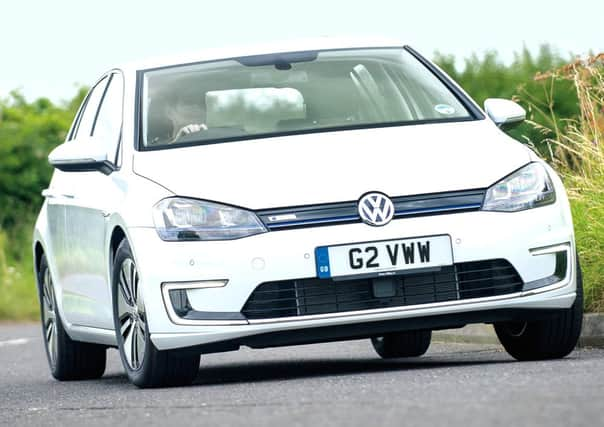First Drive: Volkswagen e-Golf


That was the day I went from refusing to accept anything beyond the internal combustion engine and dismissing any suggestion that electric cars could provide even a hint of an alternative as a practical mode of transport.
The car that changed my life was the very impressive e-up!, the all-electric version of the entry level car of the VW range. After I’d got over the obvious thought that it would go down well in Yorkshire (“ee-oop lad, that’s a fine piece of kit you’ve got there”) I was taken aback when it took me for a ride on the open road. It had a confident feel and was happy to zip away from the lights or cruise at full motorway speed without any hesitation.
Advertisement
Hide AdAdvertisement
Hide AdFrom that point on my previously blinkered perception of electric cars was dumped and while I haven’t yet started wearing open-toe sandals, I now do have a more open mind to alternative power.
But if I thought the e-Up! was good I’ve now discovered something even better. It’s bigger, faster and even more practical and has all the same technology – which is not surprising, because it’s the Up!’s big brother, the electric e-Golf and it is really impressive.
It costs around £6,000 more than the e-Up! but for your money you get a bigger, practical car which will give you a good driving range and won’t ever go near a filling station, requiring instead only an overnight charge, costing around a couple of quid.
With a list price of less than £26,000 after the government’s £5,000 Plug-in Car Grant, it works out about £2,000 more than the comparable petrol-engined Golf. I reckon the average driver would save that in fuel in a year and from that point on they’re in credit.
That’s not all though. You pay no road tax and maintenance and servicing costs are a lot lower because there are fewer moving parts to look after. There’s no oil to be changed and the brakes will last longer because once you get the hang of the system, you use the car’s regenerative power system to slow down and stop. Insurance is also cheaper.
So what’s against it? Well, there’s always going to be the range anxiety element. It’s reckoned the car can do about 118 miles on a full charge which is pretty good, but that’s variable according to how you drive it, balancing regeneration of the battery pack with how much you use the lights, heater, radio and aircon which will soak up power which could otherwise be used for motion.
Range is becoming less of an issue, especially if the car is used for the daily commute to the office. You could quite easily drive from Edinburgh to Glasgow or vice versa every day, charging it up again while sitting at your office desk.
While a three-pin 13 amp domestic supply takes 13 hours to fully charge the batteries, a home wallbox – currently offered to be fitted free – restores a fully discharged battery in eight hours and the e-Golf’s standard combined charging system and a DC supply can get it back up to 80 per cent capacity in just 35 minutes.
Advertisement
Hide AdAdvertisement
Hide AdThe e-Golf is also the first production VW to feature full LED headlights which produce brighter light and use less power than xenon headlights.
The 318-kg lithium-ion battery pack, which like the e-Up! is slung underneath in the space that would otherwise be the exhaust tunnel and the non-existent fuel tank, has a warranty of eight years or a bizarre 99,360 miles. It turns out the German models have a 160,000-kms warranty and the bosses back at base weren’t prepared to let VW UK round it up to a simple 100,000 miles.
The e-Golf is available only with five doors and a single standard trim level similar to the Golf Match. That means it comes with a 5.8-inch colour touchscreen with satnav, Bluetooth and DAB radio, aircon, adaptive cruise control, automatic lights, electrically adjustable and heated door mirrors, heated front windscreen (the test car had a £295 wireless heated screen which meant there were no visible filaments), front and rear parking sensors, rain sensor and LED daytime running lights. The test car also a £380 winter pack of headlight washers, heated front seats and heated windscreen -washer jets and a £315 advanced phone connection. Use all of that lot though and you’ll pretty soon drain that battery pack.
As well as the standard driving mode, there are also two economy profiles, Eco and Eco+, which reduce the engine’s power and output of the aircon and modify the accelerator pedal response to save energy. In addition, the regenerative braking comes in five modes, with B being the most effective to send power back to the battery when the pedal is lifted. Power output and generation can be monitored through a dashboard dial.
Obviously it is a car that has to be “learned” to get the most from it but it’s the most “normal” electric car I’ve come across and one which will fit into most people’s motoring lifestyle.
It’s certainly turned my head.
VITAL STATS
Car Volkswagen e-Golf 115PS 5dr
Price £25,845 – £27,090 as tested (after £5,000 plug-in car grant)
Engine 85KW electric, 113bhp
Performance Max speed 87mph; 0-62mph 10.5 secs
CO2 emissions 0g/km